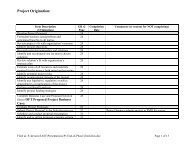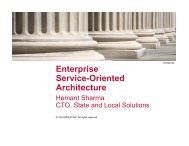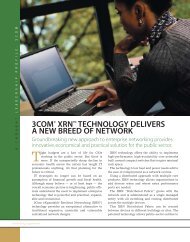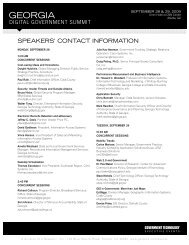Nortel Wireless Mesh Network - 1st Computer Networks
Nortel Wireless Mesh Network - 1st Computer Networks
Nortel Wireless Mesh Network - 1st Computer Networks
Create successful ePaper yourself
Turn your PDF publications into a flip-book with our unique Google optimized e-Paper software.
—The <strong>Wireless</strong> Access Point 7220<br />
can be deployed indoors or<br />
outdoors and features a rugged,<br />
weather-proof housing with integrated<br />
smart antennas. A new Duomode<br />
option allows two 7220s to<br />
be co-located and cross-connected<br />
for a four-radio co-coordinated<br />
configuration that doubles radio<br />
resources for both transit and access<br />
links to improve throughput and<br />
allow for lower latency.<br />
—<strong>Wireless</strong> Access Point 7215 is a<br />
cost-effective indoor access point<br />
that can be deployed as a fixed CPE<br />
device for mesh-based broadband<br />
wireless service, or as a seamless<br />
indoor extension for enterprise<br />
deployments. The <strong>Wireless</strong> Access<br />
Point 7215 can connect to the<br />
network via a wired Ethernet<br />
connection or wireless transit link<br />
with other 7220/7215 WAPs.<br />
<strong>Wireless</strong> Access Point 7215<br />
> <strong>Wireless</strong> Gateways logically connect<br />
the mesh network IP Subnet(s) to the<br />
enterprise’s wired network, or the<br />
service provider’s distribution network,<br />
and are responsible for routing, mesh<br />
transit link security, stateful firewalling<br />
and wireless user mobility.<br />
—<strong>Wireless</strong> Gateway 7250 features<br />
security acceleration hardware, dual<br />
10/100 Ethernet interfaces with<br />
expansion slots, and support for up<br />
to 120 <strong>Wireless</strong> Access Points.<br />
—<strong>Wireless</strong> Gateway 7240 features<br />
dual 10/100 Ethernet interfaces and<br />
supports up to 10 <strong>Wireless</strong> Access<br />
Points.<br />
Figure 3. An indoor <strong>Wireless</strong> Access Point 7215 enables seamless<br />
roaming between indoors and outdoors<br />
1<br />
<strong>Wireless</strong><br />
AP 7215<br />
802.11b/g Access Link —<br />
indoor coverage<br />
Mobile<br />
Node (MN)<br />
> The <strong>Wireless</strong> <strong>Mesh</strong> Management<br />
System is an enhanced version of<br />
<strong>Nortel</strong>’s ubiquitous Enterprise<br />
<strong>Network</strong> Management System —<br />
a common management platform<br />
shared among a wide breadth of<br />
<strong>Nortel</strong> wireless and wired networking<br />
products. The system provides a<br />
centralized utility for monitoring and<br />
managing wireless mesh network<br />
operations, including:<br />
—Discovery and visualization of<br />
<strong>Wireless</strong> Access Points, <strong>Wireless</strong><br />
Gateways and <strong>Wireless</strong> Bridges<br />
—Visualization of mesh routes<br />
—WAP status monitoring, event<br />
logging and alarms<br />
—Fault management including<br />
capturing and logging of traps<br />
and faults<br />
—Real-time performance metrics<br />
logging including utilization,<br />
error rates<br />
—Provides an intuitive user interface<br />
for monitoring and reporting<br />
2<br />
802.11a Transit link<br />
Indoor <strong>Mesh</strong> APs support two deployment models:<br />
<strong>Wireless</strong><br />
AP 7220<br />
802.11b/g Access Link —<br />
outdoor coverage<br />
1 Traditional WLAN architecture — using direct wired Ethernet connectivity<br />
Transit link<br />
2 <strong>Wireless</strong> <strong>Mesh</strong> <strong>Network</strong> architecture — using wireless transit via the neighboring<br />
<strong>Mesh</strong> <strong>Wireless</strong> APs<br />
Flexible mesh backhaul<br />
options<br />
A benefit of the mesh network architecture<br />
is that each wired access point can<br />
share its Ethernet connection among<br />
the meshed WAPs. Additional wired APs<br />
can be added to provide resiliency, or<br />
to improve throughput by decreasing<br />
the number of transit link hops to the<br />
wired network. Locations where wiring<br />
is possible are typically limited, representing<br />
the most restrictive planning<br />
parameter in any installation. <strong>Nortel</strong><br />
offers flexible mesh backhaul options<br />
that overcome this restriction and can<br />
greatly expand deployment opportunities,<br />
reach and the service potential of<br />
the mesh network.<br />
> The <strong>Wireless</strong> Bridge 7230 is deployed<br />
in pairs to create a long-range wireless<br />
link and to provide a wireless network<br />
access point for the mesh group. The<br />
bridge can be configured to operate in<br />
the 5 GHz unlicensed spectrum, or<br />
the 4.9 GHz licensed public safety<br />
band to create low-cost, high-capacity<br />
line-of-site wireless links for rapid<br />
deployment of Ethernet links.<br />
3

















